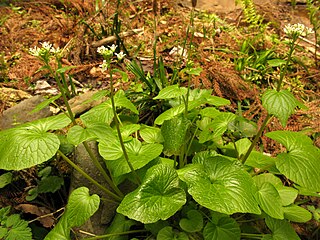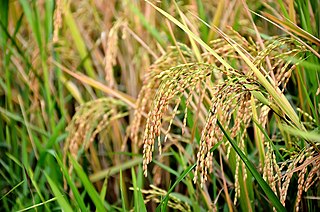
Kumquats are a group of small fruit-bearing trees in the flowering plant family Rutaceae. They were previously classified as forming the now-historical genus Fortunella, or placed within Citrus sensu lato.

Wasabi or Japanese horseradish is a plant of the family Brassicaceae, which also includes horseradish and mustard in other genera. A paste made from its ground rhizomes is used as a pungent condiment for sushi and other foods. It is similar in taste to hot mustard or horseradish rather than chili peppers in that it stimulates the nose more than the tongue. Most wasabi flavoring in commerce is, however, ersatz, based on horseradish and food coloring.

Honeysuckles are arching shrubs or twining vines in the family Caprifoliaceae, native to northern latitudes in North America and Eurasia. Approximately 180 species of honeysuckle have been identified in North America and Eurasia. Widely known species include Lonicera periclymenum, Lonicera japonica and Lonicera sempervirens. L. japonica is an aggressive, highly invasive species considered as a significant pest on the continents of North America, Europe, South America, Australia, and Africa.

Cryptomeria is a monotypic genus of conifer in the cypress family Cupressaceae, formerly belonging to the family Taxodiaceae. It includes only one species, Cryptomeria japonica. It used to be considered by some to be endemic to Japan, where it is known as Sugi. The tree is called Japanese cedar or Japanese redwood in English.

Lonicera japonica, known as Japanese honeysuckle and golden-and-silver honeysuckle, is a species of honeysuckle native to eastern Asia. It is often grown as an ornamental plant, but has become an invasive species in a number of countries. Japanese honeysuckle is used in traditional Chinese medicine.

The loquat — Eriobotrya japonica — is a large evergreen shrub or tree, grown commercially for its orange fruit, its leaves for tea, and also cultivated as an ornamental plant.

Oryza sativa, commonly known as Asian rice, is the plant species most commonly referred to in English as rice. Oryza sativa is a grass with a genome consisting of 430Mb across 12 chromosomes. It is renowned for being easy to genetically modify and is a model organism for cereal biology.

Camellia japonica, known as common camellia, Japanese camellia, or tsubaki in Japanese, is one of the best known species of the genus Camellia. Sometimes called the rose of winter, it belongs to the family Theaceae. It is the official state flower of the US state of Alabama. There are thousands of cultivars of C. japonica in cultivation, with many colors and forms of flowers. In the U.S. it is sometimes called japonica, a name more often used in the UK for Chaenomeles.
Ulmus pseudopropinquaWang & Li, occasionally known in the United States as the Harbin spring elm, is a small deciduous tree found only in Heilongjiang, the northeasternmost province in China. The tree has not been studied comprehensively, and it has been speculated it may be a natural hybrid of Ulmus davidiana var. japonica and Ulmus macrocarpa.

The Japanese angelshark is a species of angelshark, family Squatinidae, found in the northwestern Pacific Ocean off China, Japan, and Korea. It is a bottom-dwelling shark found in sandy habitats down to 300 m (980 ft) deep. This species has the flattened shape with wing-like pectoral and pelvic fins typical of its family, and grows to 1.5 m (4.9 ft) or more in length. Its two dorsal fins are placed behind the pelvic fins, and a row of large thorns occurs along its dorsal midline. Its upper surface is cryptically patterned, with numerous squarish dark spots on a brown background.

The Japanese Elm cultivar Ulmus davidianavar.japonica 'Jacan' is a cold-resistant selection from Canada. The tree was raised by the Morden Research Station, Morden, Manitoba in the 1980s.

Geoemyda is a genus of freshwater turtles in the family Geoemydidae. It contains two species:

Flutoprazepam (Restas) is a drug which is a benzodiazepine. It was patented in Japan by Sumitomo in 1972 and its medical use remains mostly confined to that country. Its muscle relaxant properties are approximately equivalent to those of diazepam - however, it has more powerful sedative, hypnotic, anxiolytic and anticonvulsant effects and is around four times more potent by weight compared to diazepam. It is longer acting than diazepam due to its long-acting active metabolites, which contribute significantly to its effects. Its principal active metabolite is n-desalkylflurazepam, also known as norflurazepam, which is also a principal metabolite of flurazepam.

Cooked rice refers to rice that has been cooked either by steaming or boiling. The terms steamed rice or boiled rice are also commonly used. Any variant of Asian rice, African rice or wild rice, glutinous or non-glutinous, long-, medium-, or short-grain, of any colour, can be used. Rice for cooking can be whole grain or milled.

Surugatoxin (SGTX) is a type of venom found in the mid-gut digestive gland of the Japanese ivory mollusk Babyloniajaponica, a carnivorous gastropod. It functions as a ganglionic blocker of nicotinic acetylcholine receptors (nAChRs). The structurally and functionally related neosurugatoxin, also derived from Babylonia japonica, is an even more potent nAChR antagonist than SGTX.

Saccharina japonica is a marine species of the Phaeophyceae plant, a type of kelp or seaweed, which is extensively cultivated on ropes between the seas of China, Japan and Korea. It is widely eaten in East Asia. A commercially important species, S. japonica is also called ma-konbu (真昆布) in Japanese, dasima (다시마) in Korean and hǎidài (海带) in Chinese. Large harvests are produced by rope cultivation which is a simple method of growing seaweeds by attaching them to floating ropes in the ocean.

Teniloxazine, also known as sufoxazine and sulfoxazine, is a drug which is marketed in Japan. Though initially investigated as a neuroprotective and nootropic agent for the treatment of cerebrovascular insufficiency in the 1980s, it was ultimately developed and approved as an antidepressant instead. It acts as a potent norepinephrine reuptake inhibitor, with fair selectivity over the serotonin and dopamine transporters, and also behaves as an antagonist of the 5-HT2A receptor.

Dioscorea japonica, known as East Asian mountain yam, yamaimo, or Japanese mountain yam, is a type of yam (Dioscorea) native to Japan, Korea, China, Taiwan, and Assam.
The hybrid elm Ulmus davidianavar.japonica × U. minor was raised at the Arnold Arboretum before 1924.
(S)-corytuberine synthase is a cytochrome P450 enzyme purified from the plant Coptis japonica, with EC number EC 1.14.19.51 and CYP Symbol CYP80G2, and catalyses an intramolecular C-C phenol coupling of (S)-reticuline in magnoflorine biosynthesis.
















